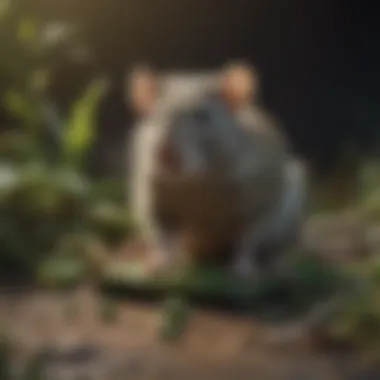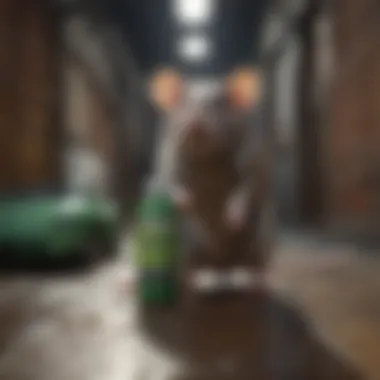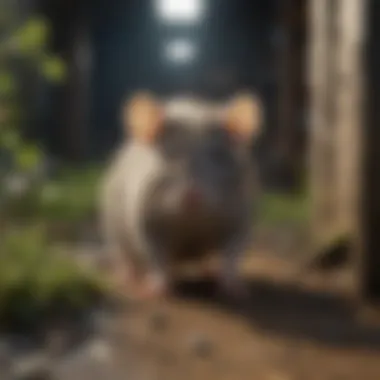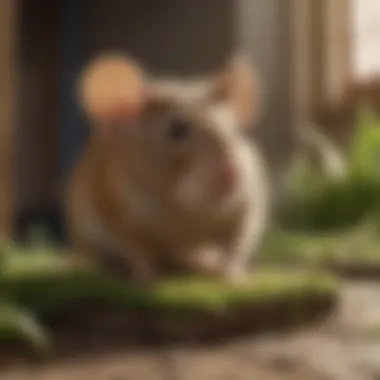Understanding Green Blocks of Rat Poison: A Detailed Review


Intro
Rat infestations can lead to numerous problems, impacting health and property. Understanding the means to control these pests is crucial for households and professionals in pest management. This article provides a comprehensive look at the green blocks of rat poison, focusing on their formulation, usage, and safety considerations. By delving into the balance between efficacy and environmental safety, this narrative informs strategies for pest control that prioritize the well-being of non-target species as well.
Understanding Pests
Definition of Pests
Pests are organisms that cause harm to humans, their property, and agriculture. In this context, rodents, specifically rats, fall under the category of pests. They multiply quickly, consume food, and damage structures, creating a need for effective control methods.
Importance of Pest Identification
Identifying the specific type of pest is vital for successful control. Not all rodents respond the same way to various forms of treatment. For example, the common rat, also known as Rattus norvegicus, often requires specific baiting tactics different from other rodents. Proper identification ensures that the chosen solution is both efficient and targeted, minimizing unnecessary risks to non-target species.
Prevention Techniques
Home and Garden Preventative Measures
Preventing a pest issue before it becomes a problem can save time and resources. Ensuring that no food sources are left outside is a fundamental step. Securing trash bins, cleaning up food spills, and storing pet food properly are effective actions. Additionally, sealing holes and gaps in buildings is crucial. Rats can squeeze through surprisingly small spaces, so vigilance is necessary to keep them out.
Seasonal Prevention Tips
Seasonal changes can influence pest behavior. In colder months, rats may seek shelter indoors. Regular maintenance checks during autumn can identify potential entry points before the winter. Also, during warmer months, ensure plants are trimmed back from the house's exterior to eliminate access points and nesting areas.
Eco-Friendly Pest Control Solutions
Overview of Sustainable Practices
There is a growing demand for eco-friendly pest control solutions. Integrating traps and natural deterrents can reduce reliance on chemical rodenticides. Understanding the ecosystem helps implement methods that minimize harm to beneficial species while effectively managing pests.
Natural Remedies and Their Effectiveness
Some households use natural remedies such as peppermint oil, which is said to repel rats. While evidence varies, the appeal of non-toxic solutions is significant. Combining these methods with traditional control can result in less environmental impact while still addressing the issue.
By understanding the formation and responsible use of green blocks of rat poison, individuals can better handle pest control in a way that is both effective and ecologically sound.
Prelims to Rodenticides
Rodenticides are critical tools in the ongoing battle against rodent infestations. Their role in pest management cannot be understated, given the significant health and economic implications posed by these pests. Infestations of rats and mice are not just a nuisance; they can lead to the contamination of food sources and damage to property. Understanding rodenticides, particularly products like the green block rat poison, becomes essential for those tasked with protecting their homes or workplaces.
Effective pest control strategies rely heavily on knowledge about these substances. Rodenticides can contribute to a comprehensive pest management plan, but they also raise important considerations regarding safety and environmental impact. This article dissectss the various aspects of these poisons, offering insights that can help homeowners make informed decisions.
The Role of Rodenticides in Pest Management
Rodenticides serve as a frontline defense against rodent populations. Their primary function is to reduce the number of these pests in a given area, thereby preventing the spread of diseases they may carry. Effective use of rodenticides can dramatically decrease the potential for larger infestations, protecting health and property.
Rodenticides are often used alongside other pest control measures, creating a more integrated approach. The key is to apply these products responsibly. Understanding the specific formulations helps in targeting the pests while minimizing risks to other animals, including pets and wildlife. Moreover, adherence to application guidelines ensures that the process is both effective and safe.
Historical Context of Rodent Control


Historically, rodent control has evolved significantly. Early methods were rudimentary, often relying on traps or poisons derived from natural sources. With increased urbanization and the rise of chronic rodent problems, there was a pressing need for more effective solutions.
The introduction of modern rodenticides has transformed how rodent control is approached. New formulations, informed by scientific research, offer greater efficacy with improved safety profiles. Over time, regulations regarding their use have also shaped the industry, driving manufacturers to develop products that are effective yet pose fewer risks. Understanding this evolution provides context for the current state of rodenticides and highlights the need for ongoing research in the field.
Components of Green Block Rat Poison
The effectiveness and safety of green block rat poison greatly depend on its components. Understanding these elements helps users make informed choices during pest management. The combination of active and inactive ingredients plays a critical role in how the poison functions and its impact on the surrounding environment.
Active Ingredients
Active ingredients are the primary agents responsible for the toxicity of rat poison. In green block rat poison, these ingredients often include bromadiolone or brodifacoum. These substances belong to the anticoagulant class of rodenticides. They disrupt the normal clotting process in the blood of rats and leads to internal bleeding. When a rodent consumes the poison, the active ingredient accumulates over several days, eventually resulting in fatal consequences.
These substances are formulated to be most effective while minimizing the risk to non-target animals. Proper usage according to the recommendations reduces accidental poisoning incidents.
Inactive Ingredients and Their Functions
Inactive ingredients in green block rat poison serve various purposes. They may include attractants, binders, or substances that ensure the stability of the active ingredients. For example, sugar or vegetable oils are often used as attractants. These help to lure rodents into consuming the poison more effectively.
Additionally, binders allow the green block to maintain its shape and resist degradation from environmental conditions. The combination of inactive components enhances usability and efficiency, contributing to the overall success of the rodent control method. Knowing these details allows homeowners to understand what most attracts rodents to the poison while also recognizing that it will withstand various environmental factors.
The Chemical Mechanism of Action
The chemical mechanism of action for green block rat poison is straightforward yet critical to grasp. Once an animal ingests the poison containing common active ingredients like bromadiolone, it starts to inhibit the synthesis of vitamin K, essential for blood clotting. The body cannot effectively coagulate blood, leading to uncontrolled bleeding.
This mechanism usually takes several days to manifest, allowing rats to remain active after consumption. The delayed effect is intentional, as it prevents bait shyness. Rodents do not associate initial illness with the poison if symptoms appear long after ingestion, increasing the likelihood of repeated consumption.
In summary, understanding the components of green block rat poison—active and inactive ingredients— and their mechanisms is crucial for its effective use in rodent control. Knowledge of these elements can guide homeowners in using this tool safely and effectively, while also minimizing harm to non-target species and the environment.
Application of Green Block Rat Poison
The practical use of green block rat poison is pivotal in effective rodent control. Proper application ensures that the intended outcome of eradicating pests is achieved without causing unintended consequences to non-target species or the environment. In this section, we delve into the specific elements that make the application of green block rat poison efficient and safe. Understanding how to apply this rodenticide correctly leads to better results, reducing rodent populations while also addressing concerns related to safety and environmental impact.
Best Practices for Application
Utilizing green block rat poison effectively requires adherence to specific best practices. Here are some key points to consider:
- Target Assessment: Begin by identifying the areas with the highest rodent activity. Look for signs like droppings or nesting sites. This ensures that you are applying the poison where it is most needed.
- Proper Placement: Place the green blocks strategically. They should be positioned in hidden areas such as behind appliances or in attics. This reduces the risk of accidental exposure to humans or pets.
- Use of Bait Stations: Utilizing bait stations can protect rodents from reaching the poison directly. It also deters non-target animals from accessing the blocks.
- Regular Monitoring: Check the bait stations regularly. Replace any used or spoiled blocks and assess whether the rat population is decreasing. This ensures that the application remains effective over time.
- Follow Instructions: Always adhere to the instructions provided on the packaging. Each product may have specific recommendations regarding usage, dosage, and placement.
These best practices not only enhance efficacy but also uphold safety standards in the application process.
Common Mistakes to Avoid
While applying green block rat poison, certain missteps can lead to ineffective or harmful outcomes. Being aware of these mistakes is essential for achieving successful pest control:
- Over-Application: Applying too much poison does not necessarily mean better results. Excessive amounts can lead to waste and an increase in risks to non-target wildlife.
- Ignoring Safety Instructions: Failing to follow the provided safety guidelines can expose individuals and pets to harm. This can also lead to legal liability if regulations are not observed.
- Neglecting to Monitor: Once the poison is applied, many may forget to monitor the situation. This can allow rodents to adapt or lead to situations where poison remains available longer than necessary.
- Wrong Placement: Placing the blocks in open areas increases the potential for accidental ingestion by pets or children. Secure placement is crucial for safety.
- Underestimating the Problem: Assuming that a minimal number of rodents can be eliminated with a single dose can lead to greater infestations as the population grows.
Avoiding these common mistakes is crucial for effective pest control and safety. Proper approaches and vigilance will not only decrease the rodent population but also protect the surrounding environment from the dangers of improper pesticide application.
Safety Considerations


The use of green block rat poison carries with it a considerable weight of responsibility. Understanding the safety considerations surrounding its application is crucial for both effective pest control and the protection of human and animal health. By recognizing the risks and adopting best practices, homeowners can significantly mitigate potential dangers while ensuring successful management of rodent populations.
Risks to Human Health
Green block rat poison, despite its efficacy in rodent control, poses specific risks to human health. Accidental exposure can occur through improper handling or accidental ingestion. Symptoms of exposure may include nausea, vomiting, and in severe cases, more critical health issues may arise. It is essential to understand that children are often more susceptible to these risks. Therefore, keeping these products securely stored away from areas frequented by children and monitoring the application sites can greatly reduce the risk of accidental poisonings.
Moreover, exposure is not limited to ingestion. Dermal contact or inhalation of dust from the blocks can also pose health threats. Ensuring that gloves are worn during application and cleaning can reduce direct contact significantly. Homeowners should familiarize themselves with the Material Safety Data Sheet (MSDS) for specific product details as this document outlines handling, storage, and emergency measures.
Risks to Pets and Non-Target Animals
The ecological implications of green block rat poison extend beyond human health, raising grave concerns regarding the safety of pets and non-target wildlife. Pets, particularly dogs and cats, can encounter these poisons accidentally. Ingestion can lead to severe toxicity and potentially death. It is therefore important to supervise animals closely during the application period and ensure that any unused blocks are securely stored out of reach.
Additionally, non-target animals that may come into contact with the poison—whether through direct ingestion or secondary poisoning—face similar risks. The effects can cascade through the food chain, impacting not only local fauna but also leading to imbalances within ecosystems. It is vital for homeowners to avoid placement of rat poison in areas frequented by these animals, thus reducing unexpected tragedies.
Protective Measures During Use
Implementing proper protective measures during the use of green block rat poison is vital to safeguarding health and safety. Here are some recommended precautions:
- Read the Label: Always follow the instructions and safety advisories listed on the product label.
- Wear Protective Gear: When handling the poison, wear rubber gloves, masks, and eye protection to minimize exposure risks.
- Store Safely: Keep the product in its original container, securely locked away from children and pets.
- Educate the Household: Inform family members about the dangers of the poison and encourage them to avoid treated areas until deemed safe.
"Proper application and strict adherence to safety regulations can result in effective rodent control while protecting human and pet safety."
By understanding and addressing these safety considerations, readers can ensure that their pest control measures are both effective and responsible. The ultimate goal is to manage rodent populations without compromising the health of humans, pets, and the surrounding environment.
Environmental Impact of Green Block Rat Poison
The consideration of the environmental impact of green block rat poison is vital when discussing its use in pest management. Understanding how these products interact with the ecosystem can lead to more responsible application practices. Rodenticides can mitigate rodent populations effectively, but they also present risks to non-target wildlife and the overall health of ecosystems.
Educating homeowners and pest control professionals is essential, as responsible usage of these poisons relates directly to minimized harm to both environment and health. Problems arise when these products enter food chains, potentially causing secondary poisoning in animals and even humans. Therefore, it is necessary to weigh the benefits against the consequences of using such chemicals.
Effects on Wildlife
Wildlife is often impacted by rodenticides through direct and indirect exposure. When animals consume poisoned rodents, they may suffer from toxic effects. Birds of prey, such as owls and hawks, are among the most affected by secondary poisoning. Studies have shown that the consumption of poisoned rodents leads to a significant decline in their populations, which disrupts the natural predator-prey balance.
Some species, like raccoons and foxes, may scavenge from the environment, exposing themselves to these poisons without directly consuming the bait. This predilection emphasizes the need for targeted pest control methods that minimize broader ecological consequences.
Ecosystem Imbalances
The use of green block rat poison can lead to ecosystem imbalances. When rodenticides eliminate a significant portion of rodent populations, there can be cascading effects on the food web. For instance, a sudden decrease in rodent numbers can affect their predators, leading to food shortages that may decrease predator populations as well.
Moreover, as rodents decline, other pests may move into the area for food, causing potential new infestations. The reliance on green block rat poison should be viewed as part of a broader pest management strategy to maintain balance in local ecosystems.
Regulatory Framework for Rodenticides
The regulatory framework surrounding rodenticides, such as green block rat poison, is essential for ensuring safe use and minimizing potential hazards to humans, pets, and the environment. These regulations are formed by various government bodies, which set standards that manufacturers must adhere to. By understanding the regulatory landscape, we can appreciate the importance of these guidelines in promoting safe practices and maintaining the integrity of pest management.
Government Regulations and Standards
Different countries have established specific regulations that govern the production and distribution of rodenticides. In the United States, the Environmental Protection Agency (EPA) oversees the registration and use of these chemicals. This body evaluates the safety and effectiveness of rodenticides before they are approved for market distribution. The standards may include toxicity levels, environmental risks, and stipulations regarding usage.


For instance, products must undergo rigorous testing to establish their safety for non-target species, such as wildlife and domestic pets. These assessments include detailed studies on the acute and chronic effects of active ingredients. The EPA also requires manufacturers to provide data demonstrating that their products will not significantly harm the environment or pose undue risks to human health.
Keeping track of these regulations ensures that homeowners and pest control professionals are using safe raticides that have undergone extensive scrutiny. Non-compliance can lead to penalties for manufacturers but also to serious risks for users and unexpected ecological effects.
Labeling and Compliance Requirements
Labeling is a critical aspect of the regulatory framework. A product's label offers essential information on how to use it safely. This includes dosage, frequency of application, and safety precautions. Compliance with these labeling requirements is mandatory for manufacturers and users alike.
A well-structured label will not only highlight the active ingredients but also provide clarity on any specific risks associated with the product. Homeowners must read these labels carefully. They should be aware of the directions for safe handling and application to minimize potential risks to themselves, their families, and the environment.
Additionally, misinformation or inadequate labeling can lead to misuse of the product. This misuse can exacerbate an infestation problem or lead to unforeseen consequences, such as exposure to pets or children. Regulatory compliance is crucial in ensuring that the public can trust the efficacy and safety of these rodenticides while also maintaining the ecological balance.
In summary, the regulatory framework for rodenticides affirms a commitment to safety and responsibility. By adhering to these guidelines, manufacturers contribute to effective pest management that prioritizes both human safety and environmental protection.
Alternatives to Green Block Rat Poison
As we explore the alternatives to green block rat poison, it becomes apparent that there are diverse methods to tackle rodent issues without relying solely on traditional rodenticides. These alternatives not only consider the immediate goal of pest control but also emphasize the importance of safety for humans, pets, and the environment.
Eco-Friendly Pest Control Methods
Eco-friendly pest control methods offer sustainable solutions for managing rodent populations. These strategies often focus on prevention and habitat modification, reducing the appeal of homes to rodents.
One common approach is proper sanitation. Keeping food stored securely and maintaining a clean environment can significantly decrease rodent attraction. Sealing entry points also plays a crucial role. This includes repairing gaps in walls, closing off any holes in the foundation, and ensuring windows and doors fit snugly. By blocking access, we can often deter rodents from even entering the premises.
Natural deterrents are another aspect of eco-friendly pest control. Some homeowners use essential oils, such as peppermint or eucalyptus, which rodents typically find unpleasant. Spraying diluted oils around potential entry points may help in keeping them at bay.
Here are a few common eco-friendly methods detailed:
- Traps: Traditional snap traps or more humane catch-and-release traps can be effective without harming non-target animals.
- Predator Urine: The scent of predator urine can create a natural fear response in rodents, discouraging them from nesting nearby. This method is particularly popular in outdoor settings.
- Encouraging Natural Predators: Attracting owls or hawks can provide a natural form of pest control. Nesting boxes can be installed to invite these birds to the area.
Psychological and Behavioral Control Strategies
Psychological and behavioral control strategies focus on altering rodent behavior through environmental manipulation and learned responses. Unlike chemical methods, this approach emphasizes understanding and influencing the nature of the problem.
One effective tactic is the use of sound and light to create discomfort for rodents. Ultrasonic repellers emit high-frequency sounds that humans cannot hear but may be distressing to rodents. However, the efficacy of these devices can vary, making it essential to assess individual situations.
Another strategy involves modifying the environment to disrupt rodent behavior. For example, using barriers made from wire mesh can prevent rodents from accessing gardens or livestock areas. Creating a less hospitable habitat can be a powerful method for control.
Additionally, educating residents on rodent behavior can influence how they address the issue. Understanding that rodents are creatures of habit can guide efforts to disrupt their nesting and feeding patterns. For instance, moving bird feeders away from the home can reduce the likelihood of rodents being attracted by the spilled seeds.
End
The conclusion of this article serves as a critical reflection on the previously discussed elements surrounding green-block rat poison. It emphasizes its relevance within modern pest control practices while addressing both its practical application and associated risks. Understanding these nuances promotes informed decision-making for homeowners and pest management professionals alike.
Summary of Key Points
To synthesize the information presented, several key points emerge:
- Composition and Function: Green block rat poison contains specific active ingredients designed to effectively control rodent populations. This knowledge is essential for proper use and safety considerations.
- Safety: The potential risks to human health and pets underscore the need for careful application and adherence to safety measures.
- Environmental Impact: The effects of these rodenticides on wildlife and ecosystems are significant. Awareness of these impacts can guide more responsible use.
- Regulatory Framework: Government regulations are in place to ensure safe usage and labeling, emphasizing compliance in pest management.
- Alternatives: Exploring eco-friendly pest control methods can provide homeowners with safer options that align with ethical considerations.
Future Considerations for Pest Management
Looking ahead, pest management strategies must adapt to changing environmental conditions and regulations. Future considerations may include:
- Integration of Technology: Utilizing technology in pest management can enhance effectiveness and efficiency. Sensors and smart traps may offer innovative solutions.
- Consumer Education: Increasing public awareness about the risks associated with rodenticides and the availability of alternatives can foster responsible usage.
- Research and Development: Continuous research is crucial for developing safer, more efficient pest control methods that minimize harm to non-target species.
- Policy Changes: As more is understood about the ecological impacts of rat poison, regulatory changes may shape the industry, emphasizing sustainability and safety.
In summary, understanding green block rat poison involves a multi-faceted approach that requires ongoing education, adherence to regulations, and consideration of environmental impacts.



